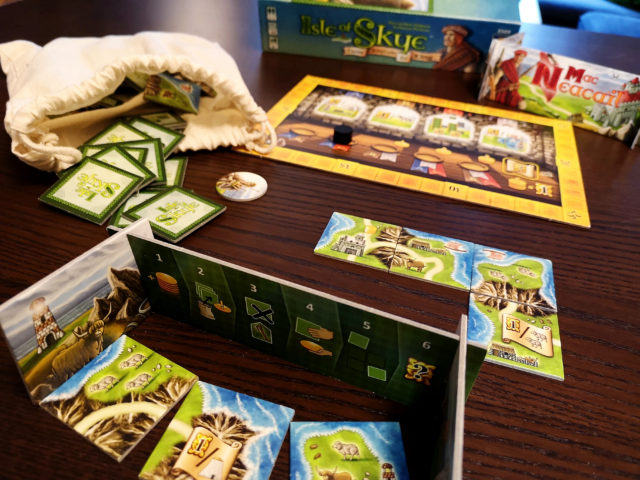When Isle of Skye came out in 2015, I first played it and thought “Cool, that’s a good game.” It quickly fell out of my mind until I found a copy on the dusty shelves of a store going out of business. So it goes. “For $15.00,” I thought, “I’ll happily add this to my collection.”
Since that point last year, Isle of Skye has quickly become one of my go-to games when hosting friends for gaming. It’s impossible to look at or play the game without immediately seeing how it is reminiscent of some of the earlier tile placement games of Carcassonne and Alhambra. To simply compare Isle of Skye to Carcassonne without any more information is a little reductive, though. Carcassonne does what it does well, but Isle of Skye wanted to do more. More ways to score, more rules, more choices, and even more tiles (I kid you not, the base Carcassonne has 72 tiles and Isle of Skye has a whopping 73 – I wonder if that’s accidental)!

In Isle of Skye, your goal is (unsurprisingly) to score as many points as possible. Each player is building their own little personal tiled area and trying to score points at the end of each round. Scoring is variable, using different scoring windows to determine what is worth points each round, so you will likely not play any games with identical scoring mechanics. On top of that, tiles are not drawn to determine what you get to play. That’s right, Isle of Skye introduces a full economy to the tile-laying mechanics! Each round, each player draws three tiles, assigns a price to them, and then takes turns purchasing tiles from other players. Following that, each player must purchase any tiles still in front of them for the price that they assigned to it.
All of these mechanics come together well to create a relatively light tile laying game that keeps me interested. The tiles are quite diverse, featuring sheep and bison and farms and lighthouses and brocks and whiskey barrels, and many of those features have minimal effect depending on the specific game’s scoring windows.
And it gets spicier still!

Isle of Skye has two expansions: Journeyman and Druids. Druids keeps everything you already like about Isle of Skye but adds a separate board with extra tiles on it. Effectively, Druids just makes Isle of Skye a little bit more, adding tiles and money and some special abilities. It’s the expansion to play if you just want your expansions to provide more of the same.
Then there is the Journeyman expansion… Now, if you have ever been playing Isle of Skye, having a good time, but thinking “Wow, I really wish this game was a little bit more like a dry, themeless Euro,” then boy, oh boy, is this the expansion for you!
While it may not be entirely clear, I consider the above to be an incredibly positive review of Isle of Skye: Journeyman. It primarily adds two main things. It adds a personal board for each player which allows them to track the stops made by their journeyman (a little like 7 Wonders Armada, truly), and it adds the journeyman himself, a wooden pawn that you will move across your Isle each turn. The main mechanic involves plotting a route each turn with cubes, which your journeyman can then travel to and pick up. Each time a cube is picked up it allows the player to make progress on that personal board based on where the cube was picked up from. The different tile features come into play here, even if they aren’t part of the scoring windows – a nice way to give a little bit more value to all the wonderful things drawn on the tiles. The requirements to make progress on the personal board are static from game to game, but it contains special abilities that slot into modular spots for unlocking. The requirements range from picking up the cube off of tiles that contain: sheep, farms, brocks, the westernmost tile, a tile connected to a completed lake and mountain, etc.

Journeyman, while I obviously adore it, certainly falls into the category of a “sometimes expansion.” I will not include it if the players haven’t played Isle of Skye before. I will not include it if I want Isle of Skye to be what it is out of the box: a 45-minute economic tile-laying game. But if I want 90 minutes of crunchy decisions and analysis paralysis in a tightly designed game, Isle of Skye with both expansions is an easy choice.
So the next time you’re looking for a lightweight economic tile-laying game, pull out Isle of Skye. And the next time you’re looking for a medium-weight, crunchy economic tile-laying game, pull out Isle of Skye.
Thanks for the review. I purchased a copy of this recently and hope to play it soon. I am big fan of Carcassonne and tile laying games in general. I think this should be a hit with me.
Hi David,
I’m glad you gave it a shot, and I hope you enjoy it! I imagine you will if you like tile laying games. Cheers!